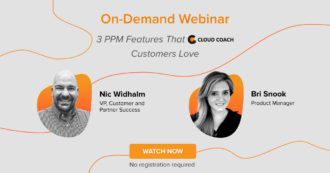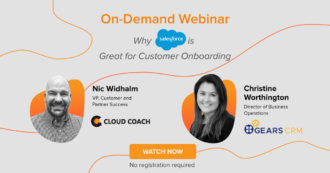 Webinar
Webinar
- Solutions
- Customer Onboarding
- Customer Success
- Professional Services Automation
- Project Management
- Project Portfolio Management
-
Solutions
-
Features
- Why Cloud Coach
- Customers
-
Resources

No matter what vertical your business operates in, an important aspect of doing business is the success of your customers. Without your customers, you have no business.
Customer success is what drives business growth, and global marketers are prioritizing metrics related to customer success now more than ever—from customer satisfaction (75%) and content engagement (73%) to customer retention rates (72%). These factors of customer success are all small parts of a big picture in your business.
B2B customer success is the practice of ensuring customers are satisfied and successful in using your products and services. It involves understanding customer needs, providing customer-centric solutions and services, and proactively engaging with customers to ensure that their needs are met. It helps build customer loyalty, drives customer satisfaction and increases customer retention. B2B customer success is a critical component of any successful business, as it helps to ensure that customers remain successful and satisfied in the long-term.
This blog is designed to help you understand what customer success is, what challenges are involved, and more. In all, this beginner guide will cover:
- What is customer success?
- Top priorities for best customer success
- The biggest challenges for customer success teams
- What does a customer success journey look like?
- Best strategies for customer success
- How to implement a customer success strategy in your business
- How to measure customer success
- What to do in cases of customer failure
- Get the right tools for the job: customer success software
By the time you finish reading the guide, you’ll have a better awareness of the importance of customer success, and be well on your way to building a customer success strategy for your own business.
Understanding B2B customer success
In the B2B world (especially in the Software as a Service industry), customer success is defined as a measurement of the customers’ outcomes from using your product or service, but it’s also a little more than that:
“Customer Success is not just about helping to solve a problem. It’s about finding an optimal solution and tailoring it to the customer’s needs” — Małgorzata Mikulska (Customer Success Director at GetResponse)
Generally speaking, it’s a sliding scale between success and failure from your customers’ points of view. But what does that mean?
Well, if you think about it, when a customer has a successful outcome by using your product or service then they’re likely to stick around and keep using it. Whereas if the customer’s outcome is less than favorable, then they’re going to ditch it as soon as possible—or even worse, tell their network they had a bad experience.
Unless your business is purely transactional (which is rare these days), the relationships you build with your customers are more important than ever. What’s more, you want them to succeed with their goals—your customers’ success = your business’s success.
So to increase your customer retention and growth, you’ll need to figure out how to navigate the world of customer success.
ADDITIONAL LINKS
Top priorities for best customer success
When it comes to customer success, it pays to have your priorities in order. In this section, we’ll show you what businesses find to be the most important part of managing and generating customer success in their respective verticals.
Of course, these listed priorities aren’t exhaustive, and you might find some of them to be less or more important to your business than others. Even still, they are worth keeping tabs on as you go about your customer success journey.
Without further ado, here’s what you need to consider as priorities:
Improving the customer experience
First and foremost, your business should care about improving the customer experience. A fundamental part of customer success is ensuring that your products and services meet the needs of your customers.
If you build a product or service with a “set and forget” approach, you’ll be unlikely to experience any growth. People’s needs evolve, and if your business doesn’t evolve with them, they’ll leave you behind.
For example, when asked about top priorities in customer success, Anders Rydholm (Founder and CEO of PrimetimePokemon) said:
“I’m most focused on how we can improve the user experience for people who sign up for our service. I think this is really important because it helps ensure that people will come back for more—and that they’ll tell their friends about us, too.”
For Anders, improving the customer experience meant they were able to not only improve retention but also get some growth via word-of-mouth recommendations from existing customers.
Hire the right people
Another top priority for businesses focusing on customer success is hiring the right people for the job. If you’re a team of one, it can be quite difficult to manage every part of the business—including the after-sales customer relationships. So naturally, at some point, your team is likely to grow with your business.
Having the right role and person to fill it is a great move to make early on, as Jane Portman (Co-Founder of Userlist) found:
“Over the last year at Userlist, we had a fascinating journey of defining “customer success” and hiring the right person for the job. It all started with proactive customer success with a less technical hire, but that wasn’t the right fit for our business. Too many technical questions were escalated [to] the engineering department.
We regrouped, and had a strategy call with a customer success consultant. As a result, we shaped the role as Customer Success Engineer, which is a much better fit.”
As a result of the right role and hire for the job, the customers at Userlist have a better experience of the service. We’ll discuss how to get the right people for customer success for your business in more detail in a later section (how to implement a customer success strategy).
Being responsive to customer inquiries
At times, great customer service and customer success strategies overlap. This is the case when it comes to being responsive to customer inquiries.
If a customer asks your team a question about your product or service and you leave them unanswered for too long (or worse, no answer at all), then that customer is likely to experience some form of failure instead of success.
For example, if a customer gets stuck when trying to use a part of a software tool and asks for help but doesn’t get a satisfactory response, they’re not going to be able to use it to fulfill their needs.
On this, Jane Portman also added:
“Response time is critical: when someone is inspired to set up their email automation, we don’t want that inspiration to fizzle out.”
Response times are especially important in the realm of digital products and services—according to a 2021 customer experience benchmark survey, over 35% of businesses said slow response times negatively impacted the adoption of digital channels.
Give customers an easy way to offer feedback
Another incredibly important aspect of customer success is feedback. If you don’t get feedback on your products or services, how do you know it’s serving your customers’ wants and needs?
The best way to ensure you get good feedback is to ask, preferably more than once during your relationship with the customer.
Great times to ask for feedback are during/after signup (e.g. how did you hear about us?), after a product/service tutorial or walkthrough if applicable, after a specified period of product/service use (e.g. after one month), and especially exit surveys to find out why people leave.
Define how you measure and track customer success
Finally, another top priority for businesses managing customer success is tracking appropriate metrics to help inform what is and isn’t working.
Methods of measuring and tracking customer success can vary considerably depending on the industry or vertical a business is in, but it’s nonetheless important to define them for your business.
For example, when asked about measuring and tracking customer success, Jane Portman of Userlist mentioned the following regarding response times (a prerequisite for CS):
“—we don’t measure it precisely, because ticket complexity varies, and quality matters more than speed.”
On the other hand, Anders from PrimetimePokemon said:
“We measure customer success by tracking metrics like: number of users who use the app within 24 hours of signing up; number of users who return after one week; number of users who return after two weeks; average amount of time spent using the app per day; average amount of time spent using the app per week; etc.”
As you can see, depending on the style of your customer success strategy, you can have qualitative, sentiment, or opinion-based measurements, and quantitative, data-heavy ways of measuring success.
Even if you end up with a mix of approaches, defining your business’ methods and sticking with them will help you get the insights you need to build on your CS strategy.
With these priorities in mind, we can also look at some of the biggest challenges customer success teams face in their day-to-day tasks—some will relate to the priorities we’ve discussed above, while others are situation-based challenges.
Helpful Resources
See Cloud Coach In Action
We’d be happy to provide a bespoke 1:1 demo on how Cloud Coach can benefit for your business.























